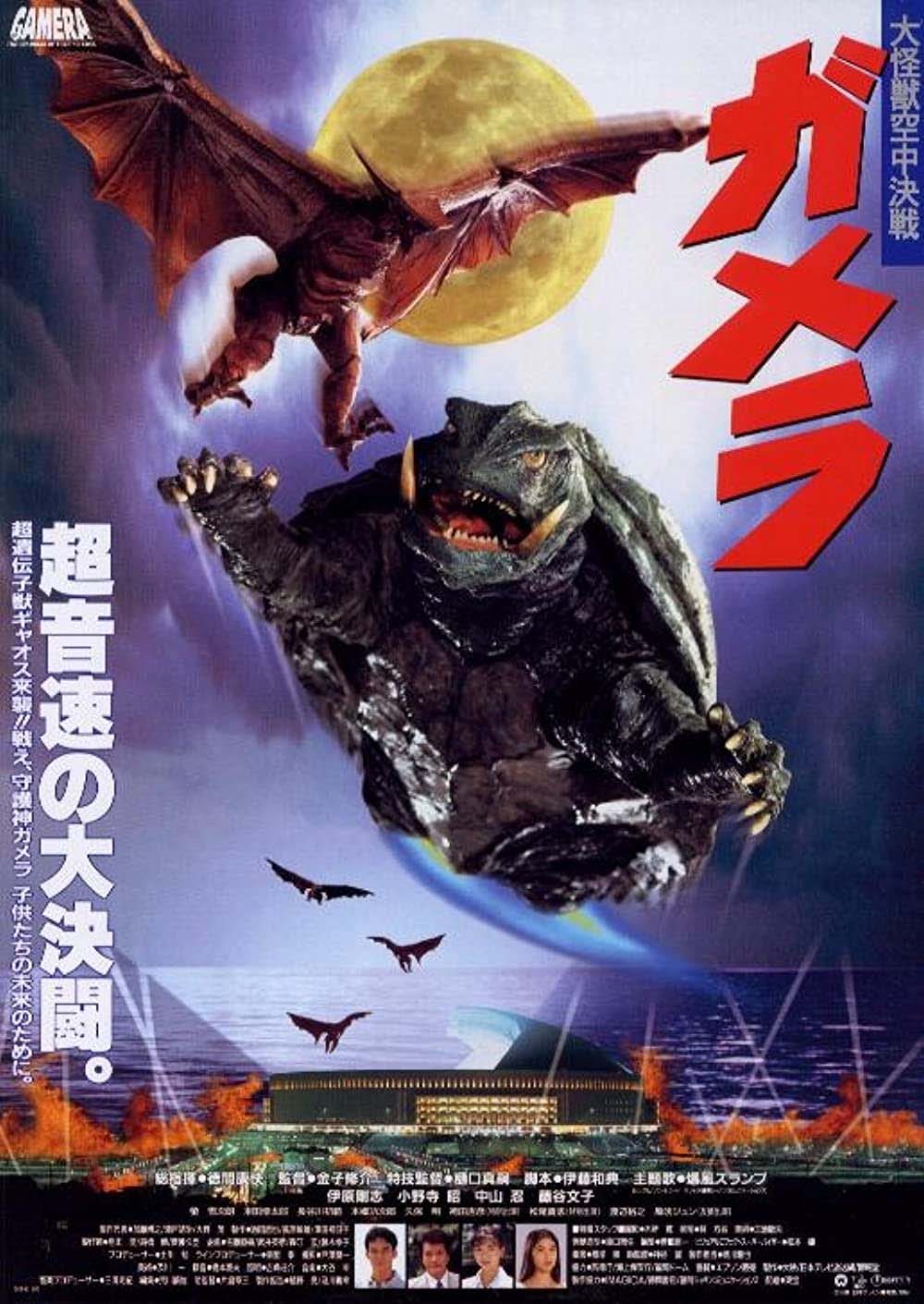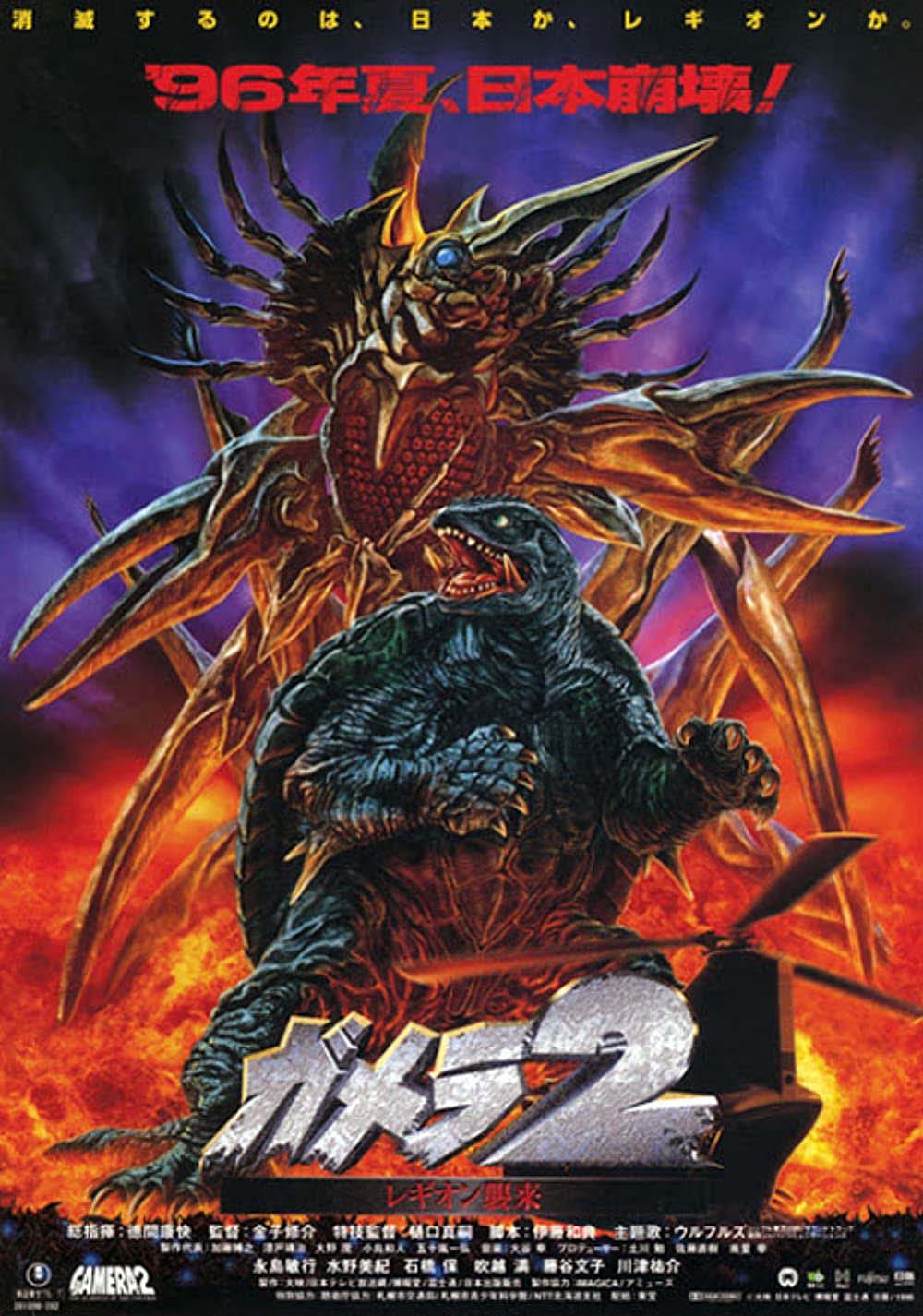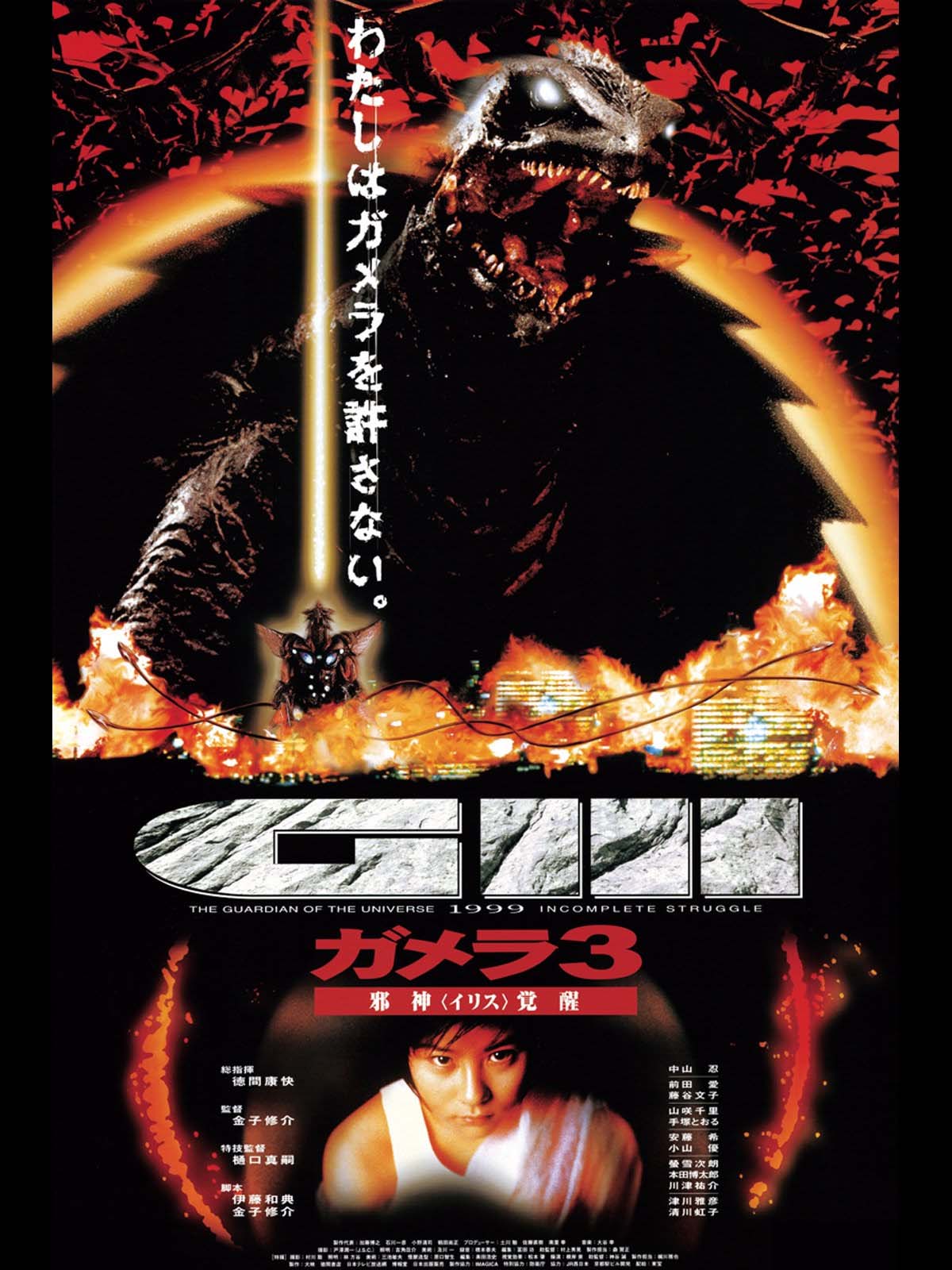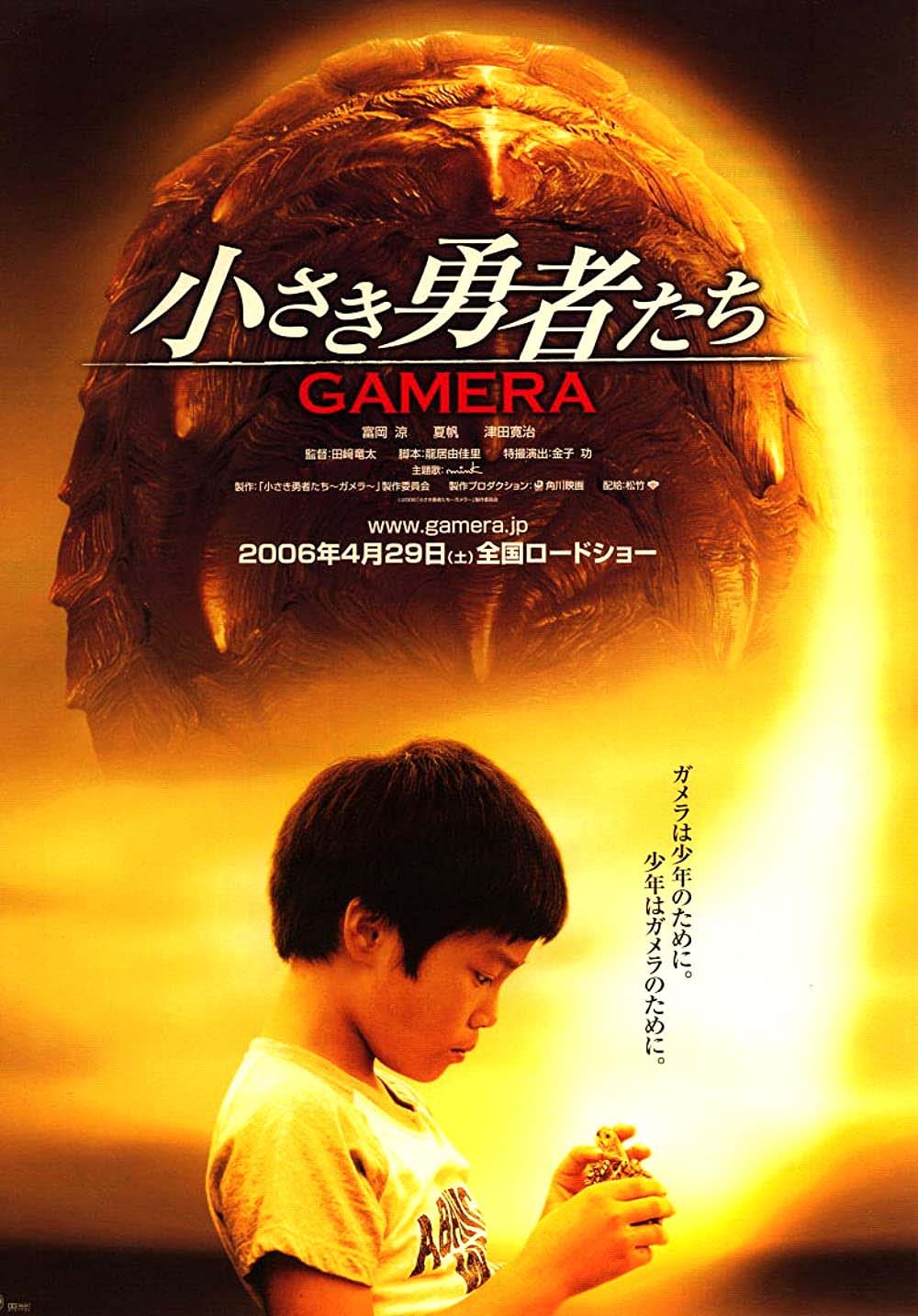A Look Back on the Gamera Films from the 1990s
When it comes to giant monsters from Japan, two companies have reigned supreme: Toho with Godzilla and Daiei with Gamera. Unlike Godzilla, Daiei always presented their creature as a sympathetic creature. Even during his original film, where he appeared to terrorize Japan, he went out of his way to save the life of a young boy. Thus, the monster quickly moved into the position that popularized him during the 1960s, the Friend of All Children.
His films appealed to the youth across the world by featuring children. Where Godzilla gained popularity as the omen of the nuclear age, Gamera garnered the love of children. This move greatly benefitted Daiei since they lacked the funds that Godzilla had to produce high-quality suits and sets. As the Gamera films continued, stock footage became more prevalent. By 1971, Daiei stopped all production of Gamera films as they filed for Bankruptcy.
After decades of building themselves back up, Daiei became ready for a triumphant return of their flagship monster in 1995. For a decade, Godzilla had reigned unopposed during the Heisei era. So, Daiei decided to modernize Gamera both with new special effects and a darker, more modern tone. Thus, they generated three of the most celebrated Gamera films to ever exist.
Join us as we look back at the Heisei Gamera films from the 1990s
Gamera: Guardian of the Universe (1995)

Resetting the Gamera mythos, the first film of the Heisei series ignored all of the movies from the Showa area. None of the characters had any preconceptions of Gamera nor the ultimate threat to humanity, Gyaos. So, it became reasonable that the Japanese government nor the military knew which monster to react to as they terrorized the Japanese landscape.
While Gamera easily destroyed buildings and city streets just by walking, the multiple Gyaos birds happily feasted on humans. Even though there were three known Gyaos by the time they flew to the Japanese mainland, the monsters stood not much taller than humans. Assuming that they could easily handle the birds, the military focussed their efforts on Gamera.
The film also delved further into Gamera’s backstory, which had been vague during the Showa era. While some of the films hinted at connections to Atlantis, Guardian of the Universe cemented that lost civilization, Mu, had genetically engineered both Gyaos and Gamera. While the civilization lost control of Gyaos, they left Gamera behind as a defender of the Earth. They also provided amulets that would tie Gamera to the spirit of a human.
Notably, while Gamera became bound to a young adult woman, Asagi Kusanagi, he had no distinct connections to children. Overall, the movie focused on adult actors, leaving the children in the background. Thus, the rebooted series quickly separated itself from the original movies.
The Plot
In the Phillippines, a ship’s crew became shocked as they witnessed a gigantic landmass seem to move across their radar. Unwilling to write it off as an anomaly, Naoya Kusanagi led an investigation that uncovered a floating atoll with mysterious orichalcum amulets along with a stone slab. As they translated the slab, the giant monster Gamera woke and broke free from his stone sleep.
Elsewhere, ornithologist Mayumi Nagamine became entrenched in an investigation of supposed giant bird attacks on the Goto Archipelago. Joined by Inspector Osako, she became horrified to discover evidence that the creatures had feasted on humans. Upon setting eyes on the man-sized “birds”, she helped formulate a plan to capture the birds at Fukuoka Dome baseball stadium, using their photosensitivity to lure them in.
As Gamera stirred from his rest, Asagi Kusanagi received one of the amulets from her father and began to form a spiritual bond with him. While it was weak during the show-down with the military at Fukuoka Dome, she quickly began to share Gamera’s pain as the military hunted the turtle down. Meanwhile, Gamera focussed his efforts on eradicating the Gyaos birds, despite the military intervention.
Thanks to the misguided efforts of the military, one of the Gyaos survived long enough to feast on numerous humans, growing to titanic size. It also grew shields over its eyes, allowing it to remain active during the day. Meanwhile, Gamera suffered so many injuries that he had to rest and recover. As the Gyaos attacked Tokyo, it knocked over the Tokyo Tower so it come to build a nest there.
Luckily, Gamera fully recovered in time to eradicate the Gyaos eggs before they hatched. With Asagi’s support, he eliminated the Gyaos threat before he retreated to the sea.
Gamera 2: Attack of Legion (1996)

With the rousing success of the first film, Daiei quickly moved to produce a follow-up film. Similar to the Godzilla films during the 1990s, they decided that a recurring cast would be important to this series. So, they invited back Ayako Fujitani to resume her role as Asagi Kusanagi. Meanwhile, Yukijirō Hotaru also returned to continue to story of the beleaguered former inspector, Osako. Otherwise, the only other returning character was the titular Gamera.
Unlike the first film in the trilogy, the sequel decided to create an original foe for Gamera to face. While the giant turtle was no stranger to extraterrestrial threats in prior films, this incarnation had only fought terrestrial threats, such as Gyaos. So, this entry gave the team a chance to push the kaiju to his limits.
Like Gyaos, Legion began small, with multiple human-sized monsters. However, these creatures quickly produced, forming an immense legion that the military could not contain. With the swarm-like nature of the interstellar monsters, humans gave them the name Legion. Moreover, the legion began to seed a gigantic flower that would serve as a biological launch pad. As the flower could bring down Sapporo with it, the military had no strategy to handle the interstellar threat.
The Plot
A year after the Gyaos attack, Japan focussed its efforts on rebuilding while Gamera appeared dormant. The quiet reprieve came to an end as a meteor struck down on a mountain range, bringing an extraterrestrial threat with it. Soon after, security guards spotted giant insectoid creatures raiding a nearby warehouse. As the insectoid creatures settled in, a monstrous planet began springing up around Sapporo.
To humanity’s horror, the meteor brought an interstellar species of insects that had a symbiotic relationship with the plants growing in Sapporo. As the plants continued to grow, a gigantic flower errupted, destroying a building and raising the oxygen levels around the city. As the military surveyed the situation, they determined that the insects used the plant to launch themselves into space to colonize new worlds.
Luckily, the planetary treat of these creatures caught the attention of Gamera. While the turtle managed to tear out the flower from its roots, he could not handle the overwhelming force of the Legion. Thus, he retreated as the creatures formed a second hive at Sendai. Before the flower could fully develop, Gamera once again appeared to eliminate the plant. However, he now faced a gigantic queen version of the Legion.
After the destruction of Sendai, Gamera appeared dead, leaving the Legion free to terrorize the world. After locating a comatose Gamera, Asagi managed to reach out to him with their spiritual connection. Unfortunately, this also shattered the median and his direct connection to humanity.
As Gamera faced Legion in a final battle outside Tokyo, he used his most powerful attack, a plasma cannon in his chest, to eradicate the queen. Even though the turtle triumphed, humans feared what would happen if the creature ever saw humans as a threat.
Gamera 3: Revenge of Iris (1999)

As the Attack of Legion kept the series going strong, Daiei green-lit another follow-up to the new Gamera series. With fans loving the dark take on the gigantic turtle, the production team decided to continue in the same vein. This time, Gamera had no direct connection to humanity. So, the turtle took a more ferocious demeanor, reflected in the new suit design.
As Gamera continued to hunt down flocks of Gyaos, his actions caused potentially more damage than the monsters that he fought. So, the Japanese continue to fear Gamera much more than any of the human-eating monsters. Furthermore, one of the government’s consultants, Kurata Shinji, became convinced that Gamera was an evil spirit that could lead to the destruction of Heaven and Earth.
Likewise, this film centered around a new character, Ai Maeda’s Ayana Hirasaka, who witnessed the death of her parents during the fight between Gamera and Gyaos in 1995. Believing that Gamera directly caused the death of her family, she held a deep grudge against the monster. So, she happily helped raise a new creature, Iris, as the instrument of her revenge.
Once again, the series brought back Ayako Fujitani as Asagi Kusanagi and Yukijiro Hotaru as Osako. Moreover, this entry saw the return of Shinobu Nakayama as ornithologist Mayumi Nagamine. While Asagi played a minor role in this film, Shinobu fought to convince Ayana to let go of her grudge and break away from Iris.
The Plot
Three years after Gamera defeated Legion, the Gyaos reemerged once again in a new form, the Hyper Gyaos. As these creatures threaten the earth, Gamera chased them into Tokyo’s Shibuya district. Even though Gamera killed the Gyaos, his actions also ended the lives of 20,000 humans. Thus, the government began to seriously consider the preaching of two occult agents, Miss Asakura and Kurata Shinya.
Far away in the countryside, the young girl, Ayana, stumbled across a mysterious egg in a shrine. Originally believing that the egg would be a phoenix who would oppose the legendary turtle, Ayana helped raise the hatching. Even when she witnessed a tentacle creature emerge from the egg, she continued to believe it would be her savior. Furthermore, she located a strange orichalcum pendant that tied her spirit with this monster, which she called Iris.
As Iris grew, it wrapped itself with Ayana in a cocoon, intending to fully bond with her life force. Before Iris reached maturity, Ayana’s classmate rescued her from the cocoon. Without Ayana’s life force, Iris terrorized and absorbed the life force of the people around the town.
Now in the hands of the government agents, they brought Ayana to Kyoto in an attempt to summon Iris there. As Iris flew to Kyoto, it drew the attention of Gamera, who struggled to take the monster down. Despite Gamera’s best attempts, he could not prevent Iris from reaching Ayana, where it attempted to complete their merge.
As Ayana began the merge with Iris, she realized that Iris had murdered the town with her help. Luckily, Gamera tore her from the creature’s chest before he eliminated Iris for good. Even with Iris defeated, a huge flock of Gyaos threatened to descend upon Japan.
Gamera: The Brave (2006)

In many ways, Gamera: The Brave is not a proper part of the Heisei series. Like the Millenium series for the Godzilla films, this film rebooted the series. However, the film did not generate a series of its own either.
Unlike the Gamera trilogy from the 1990s, Gamera: The Brave attempted to return the kaiju to its roots, where the series strongly focussed on children. Where Gamera’s benevolence came into question as the trilogy continued, Daiei hoped to restore Gamera’s position as the Friend to All Children with this film. So, they set forth to create a much lighter adventure for their monster.
Further strengthening the desire to make Gamera cuddly once more, the turtle spent most of the film in a juvenile form. For most of the film, the creature was referred to as Toto, for the boy had no idea that he was raising a baby Gamera.
Like the later 1990s films, Gamera: The Brave featured a new monster, Zedus, an aquatic saurian. While the threat of Zedus was felt, with it attacking ships and feasting on people, the monster’s origins remained a mystery. In many ways, this new monster guest-starred in the film, only providing a small bit of conflict.
The Plot
After many battles with monsters, Gamera became overwhelmed as he battled Gyaos in 1973. Incapable of destroying all the creatures, Gamera instead sacrificed himself with a self-destructive explosion to kill the birds. Thus, humanity moved on in a world without Gamera.
33 years later, Toru Aizawa discovered a mysterious egg at the site of Gamera’s demise. As the egg hatched into a small tortoise, the boy decided to name the newborn Toto. Toru quickly discovered that Toto had several mysterious powers, including levitation and a rapid growth rate. Since the boy feared being left alone, he became determined to keep Toto, despite his growing size, hiding him away.
As Toto continued to grow, Japan faced the terrible threat of a man-eating Kaiju from the sea, Zedus. As the monster moved from terrorizing ships to the city, Toru and his friends found themselves in danger. Luckily, Toto intercepted Zedus to protect the children, proving that the creature was a young Gamera.
After Zedus injured Toto during their fight, the government captured both the turtle. Aware of Gamera’s benevolent nature, they helped the turtle recover his strength. To achieve this, they used the power of the red stones from the former Gamera’s death site.
As a nearly full-grown Gamera faced against Zedus once more, Mai realized that the turtle needed the red stone that Toru gave to her. Even though her surgery weakened her, the stone connected with the children around the area to have them relay the stone to Gamera. Upon receiving the power of the stone, Gamera had the power to overpower the sea kaiju.
The Legacy of the Heisei Gamera films from the 1990s
Years after the 1990s Gamera trilogy hit theaters across Japan, fans still fondly remember this era. To many, these films represent the best entries from Gamera’s filmography. Many who traditionally felt that Gamera was too childish for their tastes fell in love with the Heisei era incarnation. However, the darker, adult tones of the trilogy moved the turtle away from his classic representation.
Do you have old and used Gamera or Godzilla toys?
If you have a collection of old and used toys, you can turn those toys into cash. There is no reason to let those old toys collect dust. Contact us today to sell your Gamera or Godzilla toy collection.
About the Author
Chris Ingledue is the founder and owner of Wheeljack’s Lab pop Culture and Toy Shop. His vision has always been to reunite customers with their favorite childhood toys and pop culture, triggering fond memories, and reigniting their imaginations. Every day he works in the “lab” where it’s Christmas 365 days a year; scouring the internet – like we did the Sears Catalog of yesteryear – for the next great treasure, awaiting the arrival of the postman as if he was Santa Claus himself and helping collectors worldwide with their own versions of Christmas. For Chris, every day as a vintage toy buyer is an absolute joy!